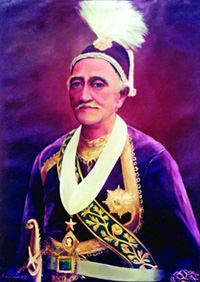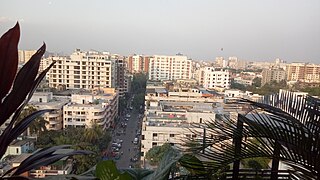
Baitul Mukarram, officially Baitul Mukarram National Mosque, is the national mosque of Bangladesh. It is located at the center of Dhaka, the capital of Bangladesh. The mosque was completed in 1968. It has a capacity of more than 42,000 worshipers.

Operation Searchlight was a military operation carried out by the Pakistan Army in an effort to curb the Bengali nationalist movement in former East Pakistan in March 1971. Pakistan retrospectively justified the operation on the basis of anti-Bihari violence carried out en masse by the Bengalis earlier that month. Ordered by the central government in West Pakistan, the original plans envisioned taking control of all of East Pakistan's major cities on 26 March, and then eliminating all Bengali opposition, whether political or military, within the following month.

Mymensingh is a metropolitan city and capital of Mymensingh Division, Bangladesh. Located on the bank of the Brahmaputra River, about 120 km (75 mi) north of the national capital Dhaka, it is a major financial center and educational hub of north-central Bangladesh. It is the administrative center of Mymensingh District and Mymensingh Division. As of 2022, Mymensingh City Corporation is the 7th largest city in terms of area and the 8th largest in terms of population in the country, with a population of 576,927 people.

Kishoreganj District is a district in Dhaka Division, Bangladesh. Earlier it was a mahakuma (sub-division) under Mymensingh district. 2495.07 km2 of land was taken from Mymensingh district to form Kishoreganj District. Kishorganj consists of eight municipalities, 13 upazilas, 105 union parishads, 39 wards, 145 mahallas, 946 mouzas and 1775 villages.

Nawab Bahadur Sir Khwaja Abdul Ghani was the second Nawab of Dhaka and the first to assume the title of Nawab as hereditary, recognized by the British Raj.

Paltan is a thana (precinct) of Dhaka, the capital of Bangladesh. It is often said to be the center of Dhaka, dividing "Old Dhaka" and "New Dhaka". Paltan was made a thana in 2005 by then Prime Minister Begum Khaleda Zia. Paltan Thana was formed on 27 June 2005 comprising part of Motijheel thana.

Dhanmondi is an upscale residential and commercial neighbourhood and a thana in Dhaka, Bangladesh, known for its central location, cultural vibrancy and being home to the country's founder, Sheikh Mujibur Rahman. Dhanmondi Thana falls within the administrative areas of both the Dhaka North and Dhaka South city corporations. It fully encompasses wards 49 and partially includes wards 47 and 48.

Ramna is a thana (precinct) in central Dhaka and a historic colonial neighbourhood. Once the site of Mughal gardens, it developed into an institutional area during British rule in the late 19th century. It became a focal point for Dhaka's modernisation in the 1960s. It was the scene of many tumultuous events that ushered the independence of Bangladesh in 1971. Ramna Thana falls under the jurisdiction of Dhaka South City Corporation.

New Market is the largest commercial shopping market in Bangladesh in north of Azimpur, Dhaka. It is situated on the opposite side of Chandni Chowk.

The Bangladesh–India border, known locally as the Radcliffe line (IB), is an international border running between the republics of Bangladesh and India that demarcates the six divisions of Bangladesh and the Indian states.

Mirpur Road is a long north–south road connecting the northern part of Mirpur and Dhaka University campus. This is one of the major roads in Dhaka. Mirpur road runs through Shyamoli, Mohammadpur, Dhanmondi. the main intersections of Mirpur road include Asad Avenue-Mirpur road, Darus-salam road-Mirpur road, Elephant road-Mirpur road, Panthapath crossing, Ring road crossing etc. The road is one of the busiest roads of Dhaka city. Numerous Buildings and skyscrapers are situated on this road.

The Sat Gambuj Mosque is near the northwestern outskirts of Dhaka in the Mohammadpur area. It is a fine example of the provincial Mughal style of architecture introduced in what is now Bangladesh in the 17th century. The mosque's most notable features are its seven bulbous domes crowning the roof and covering the main prayer hall. The monument stands in a romantic setting on a buttressed 15-foot-high bank overlooking an extensive flood plain. The mosque dates to the reign of Mughal emperor Aurangzeb, and may have been built by the Mughal governor Shaista Khan.

The Dhanmondi Shahi Eidgah, also known as Mughal Eidgah, is located in Saat Masjid road, in Dhanmondi residential area of Dhaka, Bangladesh. The Eidgah was built in 1640 CE during the Mughal era and has been in use for Eid celebration since then.

The Armenian Church, also known as Armenian Apostolic Church of the Holy Resurrection, is a historically significant architectural monument situated in the Armanitola area of old Dhaka, Bangladesh. The church bears testimony to the existence of a significant Armenian community in the region in the 17th and 18th centuries.

Gulistan is one of the busiest commercial areas in Dhaka, Bangladesh. A major transportation node, it originated around a now-demolished Pakistan-era cinema hall and is now a hub for commercial activity, particularly consumer goods. The area houses several important government establishments, including the Bangabandhu National Stadium. However, Gulistan suffers from issues such as overcrowding, traffic congestion, and criminal activity due to its dense population and commercial nature.

Aziz Ahmed SBP (BAR) is a retired Bangladeshi four star general who was the Chief of Army Staff (CAS) of the Bangladesh Army from 25 June 2018 to 24 June 2021. He was succeeded by General SM Shafiuddin Ahmed on 24 June 2021.

Dahagram–Angarpota is a Bangladeshi enclave in India about 200 m (660 ft) away from the border of Bangladesh. It had a population of 17,000 people in 2014. Dahagram–Angarpota was the second-largest enclave and the largest Bangladeshi enclave among historical Indo-Bangladesh enclaves. It is connected to mainland Bangladesh by the Tin Bigha Corridor, which is situated in Patgram Upazila of Lamonirhat district. It is surrounded by Cooch Behar district of India's West Bengal state. The Teesta river flows on its western side.
Jolshiri Abashon is an under construction residential area developed by Jolshiri Abashon corporation, a sister corporation of the Army Officers Housing Scheme, in Rupganj Upazila, Narayanganj District. It is exclusively built for Bangladesh Army officers. It was referred to by the name Army Housing Scheme in the past.

The Mausoleum of Bangabandhu Sheikh Mujibur Rahman is the mausoleum of Sheikh Mujibur Rahman, the founding leader and the first president of the People's Republic of Bangladesh. It is located in Tungipara of Gopalganj district, the birthplace of Mujib, and was designed by architects Ehsan Khan, Ishtiaque Jahir and Iqbal Habib.

















